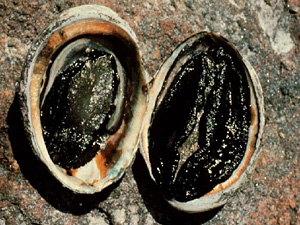 |
 |
 |
 Editorials | Environmental | April 2007 Editorials | Environmental | April 2007  
Black Abalone Nearing Endangered Species Designation; 'Global Warming, Overfishing' Cited
 Underwatertimes.com Underwatertimes.com


| | The black abalone, an intertidal mollusk ranging from Coos Bay, Oregon to Cape San Lucas, Baja California, has declined by as much as 99 percent in most of its range. |
San Francisco, California - The federal government announced it is advancing the black abalone toward protection under the Endangered Species Act. The action comes in response to a formal administrative petition filed by the Center for Biological Diversity in December 2006, which sought protection of the species. The black abalone, an intertidal mollusk ranging from Coos Bay, Oregon to Cape San Lucas, Baja California, has declined by as much as 99 percent in most of its range.

Once occurring at densities of up to 120 individuals per ten square feet, the black abalone used to dominate the southern California seascape. It was among the most common shellfish seen clinging to rocks in tidal pools. Well adapted to live in the extreme conditions of the intertidal zone, where surf meets sand and species are pounded by both waves and sun, the species has now virtually disappeared from the Southern California mainland and from many areas of the Channel Islands where it was once most abundant.

Commercial overfishing severely depleted most populations of the black abalone and was followed by the outbreak and spread of “withering syndrome,” a chronic wasting disease that has devastated remaining populations in the Channel Islands and Southern California.

While fishing of black abalone is now banned in California, withering syndrome has yet to be controlled and remains a dire threat to the continued existence of the species. Because the disease is more virulent in warm water, as the sea temperatures off California and Oregon rise in the face of global warming the deadly symptoms of withering syndrome are likely to spread to the currently unaffected abalone in the northern portion of the species’ range.

“The plight of the black abalone is indicative of what we have done to our oceans,” said Brendan Cummings, ocean program director at the Center for Biological Diversity. “The combined effects of global warming and overfishing are pushing the animal to the brink of extinction. Our oceans are in crisis, but if we squarely address this crisis even the most imperiled species, like the black abalone, will have a chance to recover.”

The National Marine Fisheries Service, the federal agency charged with implementing the Endangered Species Act for marine species, must complete its review and issue a proposed rule to protect the species by the end of 2007. The process of listing a species under the Endangered Species Act generally takes two years from petition to formal protection under the statute.

Once listed, the black abalone would join the white abalone and elkhorn and staghorn corals as the only marine invertebrates protected by the Endangered Species Act. Each of the species has achieved legal protection following Center for Biological Diversity petitions. | 
 | |
 |



